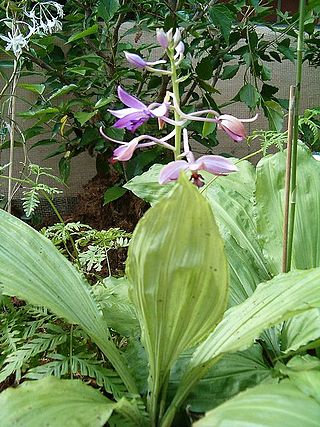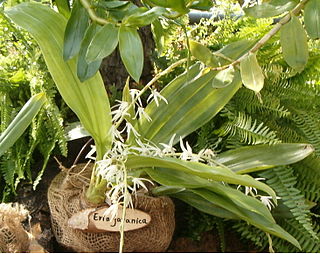
Spathoglottis, commonly known as purple orchids or 苞舌兰属 is a genus of about fifty species of orchids in the family Orchidaceae. They are evergreen terrestrial herbs with crowded pseudobulbs, a small number of leaves and medium-sized resupinate flowers on an upright flowering stem. The sepals and petals are all similar to each other and are white, yellow, pink or purple. Species of Spathoglottis are found from eastern and south-eastern Asia to Australia and some Pacific Islands.

Coelogyne is a genus of over 200 sympodial epiphytes from the family Orchidaceae, distributed across India, China, Indonesia and the Fiji islands, with the main centers in Borneo, Sumatra and the Himalayas. They can be found from tropical lowland forests to montane rainforests. A few species grow as terrestrials or even as lithophytes in open, humid habitats. The genera BolborchisLindl., HologynePfitzer and PtychogynePfitzer are generally included here. The genus is abbreviated Coel. in trade journals.

Calanthe, commonly known as Christmas orchids, is a genus of about 220 species of orchids in the family Orchidaceae. They are evergreen or deciduous terrestrial plants with thick roots, small oval pseudobulbs, large corrugated leaves and upright, sometimes arching flowering stems. The sepals and petals are narrow and a similar size to each other and the labellum usually has spreading lobes.

Zeuxine, commonly known as verdant jewel orchids, is a genus of about eighty species of orchids in the tribe Cranichideae. They are native to parts of tropical Africa, Asia, Southeast Asia, New Guinea, Australia and some Pacific Islands. They have relatively narrow, dark green leaves and small, dull-coloured resupinate flowers with the dorsal sepal and petals overlapping to form a hood over the column. The labellum has a pouched base and its tip has two lobes.

Eria is a genus of orchids with more than 50 species distributed in China, the Himalayas, the Indian Subcontinent, Southeast Asia, New Guinea, Polynesia, Melanesia and Micronesia.

Cylindrolobus is a genus of orchids with about 80 species that grow in New Guinea, Wallacea, Southeast Asia, southern China, and India.

Pinalia, commonly known as gremlin orchids, is a genus of flowering plants in the family Orchidaceae. Orchids in this genus are large epiphytic or lithophytic plants with prominent pseudobulbs, each with up to three thin, flat leaves and cup-shaped, relatively short-lived flowers with scale-like brown hairs on the outside. There are about 120 species occurring from tropical to subtropical Asia to the south-west Pacific.

Phreatia, commonly known as lace orchids, is a genus of flowering plants from the orchid family, Orchidaceae, native to regions bordering the Pacific and Indian Oceans. Plants in this genus are epiphytes, sometimes with pseudobulbs, in which case there are usually one or two leaves. Others lack pseudobulbs but have up to twelve leaves. A large number of small white or greenish flowers are borne on a flowering stem emerging from a leaf axil or from the base of the pseudobulb when present but the flowers do not open widely. There are about 220 species, distributed from tropical and subtropical Asia to the Pacific.

The genus Arachnis, abbreviated as Arach in horticultural trade, is a member of the orchid family (Orchidaceae), consisting of more than 20 species native to China, India, Southeast Asia, Indonesia, the Philippines, New Guinea, and the Solomon Islands.

Robiquetia, commonly known as pouched orchids, is a genus of flowering plants from the orchid family, Orchidaceae. Plants in this genus are epiphytes with long, sometimes branched, fibrous stems, leathery leaves in two ranks and large numbers of small, densely crowded flowers on a pendulous flowering stem. There are about eighty species found from tropical and subtropical Asia to the Western Pacific.

Trichoglottis, commonly known as cherub orchids or 毛舌兰属 , is a genus of flowering plants in the family Orchidaceae. Orchids in this genus are epiphytic plants with thick roots, relatively thick, fibrous stems and many large, thick, leathery leaves arranged in two ranks. The flowers are usually small and yellowish with light brown or purple markings. The flowers have broad sepals, narrower petals and a labellum which has three lobes and is often hairy. There are about 85 species distributed from tropical and subtropical Asia to the north-western Pacific. Most species grow in rainforest.

Pholidota, commonly known as rattlesnake orchids, is a genus of flowering plants from the orchid family, Orchidaceae. Plants in this genus are clump-forming epiphytes or lithophytes with pseudobulbs, each with a single large leaf and a large number of small, whitish flowers arranged in two ranks along a thin, wiry flowering stem that emerges from the top of the pseudobulb. There are about thirty five species native to areas from tropical and subtropical Asia to the southwestern Pacific.

Cheirostylis, commonly known as fleshy jewel orchids or velvet orchids, is a genus of about sixty species of flowering plants in the orchid family Orchidaceae. Plants in this genus are terrestrial herbs with a caterpillar-like rhizome and a loose rosette of leaves. Small, white, hairy flowers develop as the leaves wither. They are found in tropical Africa, southern Asia, Southeast Asia, Malesia, New Guinea and Australia.

Thelasis, commonly known as fly orchids, is a genus of flowering plants from the orchid family, Orchidaceae. Plants in this genus are usually epiphytes, sometimes lithophytes or rarely terrestrials. Some species have pseudobulbs with up to three leaves, whilst others have several leaves in two ranks. A large number of small, white or greenish yellow flowers are borne on a thin, arching flowering stem. There are about thirty species, distributed from tropical and subtropical Asia to the southwest Pacific.

Peristylus, sometimes commonly known as ogre orchids or bog orchids is a genus of flowering plants from the orchid family, Orchidaceae. It consists of over 100 known species found across much of eastern and southern Asia as well as in Australia and on many islands of the Indian and Pacific Oceans.

Phaius tankervilleae, commonly known as the greater swamp-orchid, swamp lily, swamp orchid, nun's-hood orchid, nun's orchid, veiled orchid, Lady Tankerville's swamp orchid or 鹤顶兰 , is a species of orchid native to areas from Asia to islands in the Pacific Ocean. It has large, pleated leaves and tall flowering stems bearing up to twenty five white, brown, mauve and yellow flowers. It was named for Lady Tankerville who was the first person to make the orchid flower successfully in England. It was the first tropical orchid to flower in England.
















